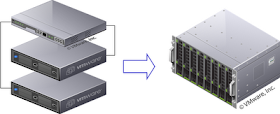
The need for network visibility in the data center and the challenge posed by converged networking and networked storage can be managed if all the switches in the data center include the sFlow monitoring standard that most vendors support.
The diagram shows the migration from stand-alone servers connected to a stand-alone switch to a blade server (collapsing the discrete servers into blades within a common chassis). In this transition, where did the switch go? Typically a blade server also encloses a blade switch that provides network connectivity to each of the blades, connecting them to each other and to the rest of the data center. The management of the blade switch may be integrated into the blade server manager and the blade switch may not be described as a switch, but it serves the function of a switch (providing connectivity by directing Ethernet packets).
Convergence blurs the traditional line between the servers and the network and it is important to identify and monitor all the switches in order to maintain visibility and control of the network. In the case of a blade server, select a blade switch with sFlow in order to manage the growing demand for bandwidth that comes with data center consolidation. Ask your blade server vendor about sFlow and select a networking solution that provides the performance, visibility and control needed to successfully operate a converged data center.

No comments:
Post a Comment